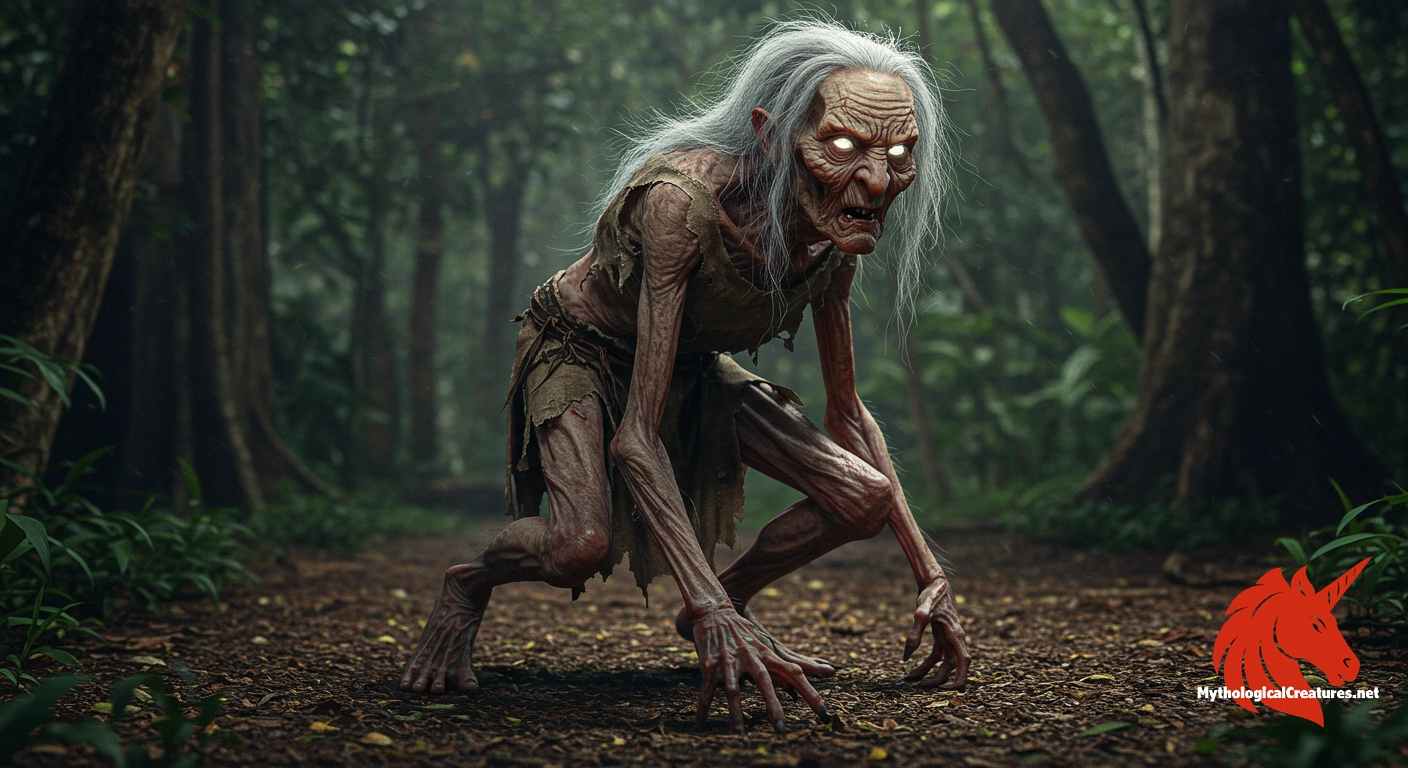Soucouyant: The soucouyant is a shape-shifting, blood-sucking hag from Caribbean folklore, notorious for shedding its skin and transforming into a fiery ball at night.

Soucouyant
Soucouyant - Embodies the nocturnal fears and supernatural retribution, serving as a reminder of the dangers lurking in the dark.
Origins & First Encounters
The soucouyant emerges from the vibrant tapestry of Caribbean folklore as a shape-shifting, blood-sucking hag whose eerie reputation has permeated local culture for centuries. Born from a blend of African, Indigenous, and European influences, this enigmatic entity has been an intrinsic part of oral traditions and community warnings. Folkloric memory recalls her first attestation in whispered village secrets and age-old storytelling sessions, where her nocturnal exploits were recounted with both dread and fascination. Her origins are interwoven with historical narratives of colonialism and the struggles of enslaved peoples, making her a symbol of latent power and retribution. The soucouyant is depicted as a seemingly normal figure by day, only to reveal a fearsome, supernatural nature after sunset, challenging perceptions of beauty and monstrosity. Embracing the duality of light and darkness, she embodies the unpredictable interplay between human vulnerability and mystic dread. The legends emphasise her role as both a seductress and a predator, enticing the unwary with promises of forbidden allure. Communities would often recite her tale as a moral allegory, warning against vanity and isolation. Over time, her myth has evolved to encapsulate the fears and hopes of generations, serving as a bridge between ancient rituals and modern narratives. The soucouyant’s legacy continues to evoke a sense of mystery, reminding audiences that the line between the familiar and the supernatural is often perilously thin.
Source Texts & Tale Variants
The primary sources for the soucouyant legend are deeply rooted in the oral traditions of Caribbean communities, where the creature’s story was passed down through generations by word of mouth. Early storytellers wove her narrative into the fabric of communal life, ensuring that each retelling captured the imagination of its audience. Colonial accounts and travel diaries occasionally mention similar hags, reflecting observations of local folklore during the early periods of European exploration. Manuscripts and early ethnographic records later attempted to document these accounts, though much of the lore remains in the realm of oral history. Multiple story variants have been recorded across different islands, each adapting the basic myth to reflect regional cultural nuances and moral lessons. Some versions elaborate on the creature’s method of blood extraction, while others focus on her ability to transform and escape detection. Distinct narratives often highlight her dual nature, portraying her as both a cursed seductress and a vengeful spirit. Folklorists have noted that the soucouyant’s tale has merged with other supernatural legends over time, creating a rich tapestry of mythic elements that vary from one locale to another. The diversity of versions underscores the flexibility of oral lore, where each retelling adapts the creature to the unique social and historical context of its audience. This multiplicity of accounts ensures that the soucouyant remains a living, evolving symbol within Caribbean myth.
Form & Powers
Descriptions of the soucouyant present her as a creature of dramatic contrast and unsettling beauty, with each narrative highlighting her mutable physical form. By day, she is often portrayed as a normally attractive woman, concealing her darker supernatural essence behind a human facade of charm and elegance. As dusk falls, her transformation begins, and she becomes a grotesque hag whose appearance is marked by gnarled features and a malevolent aura. Tales recount how she sheds her skin in a process that is as mysterious as it is horrifying, revealing an inner form that is both emaciated and ferocious. Her eyes are described as glowing with an unnatural light, hinting at the terrible power that lies beneath her seemingly frail exterior. In many accounts, long, twisted claws and discoloured, withered skin serve as visual metaphors for her corruption and danger. Some traditions speak of her size as deceptively small, allowing her to slip into crevices and shadowed corners undetected, while others depict her as towering, an imposing figure in the night. The creature’s ability to alter her form challenges conventional descriptions of physicality, blending the familiar with the monstrous. Her appearance, rich in both human allure and repulsive horror, has become almost a rite of passage among contemporary storytellers. The intricate duality of her physical depiction continues to fascinate, capturing the imagination of audiences who are enthralled by the blurred boundaries between beauty and deformity.
Regional Faces
Across the Caribbean, the depictions of the soucouyant take on a variety of regional flavours that reflect local customs and historical experiences. In Trinidad, for instance, her legend is intertwined with remedial practices where residents use herbal concoctions and protective measures to ward off her nightly assaults. On some islands, the soucouyant is depicted as more overtly terrifying, a malevolent spirit whose presence is marked by ominous signs such as smouldering embers and eerie silence. In contrast, certain communities choose to portray her with a tragic nuance, suggesting that her transformation is the result of a devastating curse or loss. Variations in attire and ritualistic practices underscore how deeply the creature is embedded in local folklore, with each community adding its unique imprint to her myth. In parts of the French Antilles, she is sometimes merged with other supernatural entities, blurring the lines between distinct spirits and emphasising a fluid cultural identity. Regional adaptations also reflect the interplay between indigenous beliefs and colonial influences, creating layered interpretations of her character. Local iconography, including the use of salt or other protective elements within households, demonstrates how communities have culturally responded to the threat she represents. These adaptations not only preserve her myth but also provide insights into the region’s historical rituals and societal norms. The regional diversity in the portrayal of the soucouyant firmly anchors her legend within the varied cultural landscapes of the Caribbean.
Cultural Parallels
The myth of the soucouyant offers a fascinating point of comparison with other global legends of nocturnal predators and shape-shifters. Similar to the European vampire, the soucouyant preys on the blood of her victims, yet she remains distinct through her pronounced transformative abilities and rich cultural roots in Caribbean life. Unlike the aristocratic elegance often associated with Western vampires, she embodies a raw, elemental power that is closely tied to local folklore and communal experiences. Comparisons are frequently drawn with the Slavic upir and other blood-sucking entities, though the soucouyant’s ability to shed her skin and re-emerge night after night further distinguishes her from these counterparts. Her dual existence as both alluring and repulsive draws parallels to mythical seductresses in various cultures who use beauty to veil their nefarious intentions. The motif of transformation, central to the soucouyant, resonates with tales from Asia and Africa where shape-shifting entities serve as symbols of both curse and redemption. This cross-cultural dialogue underscores the universality of themes such as life, decay, and metamorphosis present in folklore around the world. An analysis of these narratives reveals that while the details vary widely, the underlying anxieties about vulnerability and the unknown remain remarkably similar. The soucouyant exists as a bridge between different mythological paradigms, demonstrating how local expressions of universal fears can create unique yet relatable figures. In essence, her legend invites a comparative exploration that enriches our understanding of folklore across diverse cultural territories.
Legacy & Modern Evolution
The evolution of the soucouyant throughout history has seen her transform from a local figure of terror into a celebrated icon within Caribbean popular culture. Over the centuries, her myth has steadily permeated literature, theatre, and even film, reflecting the shifting dynamics of societal fears and artistic expression. Modern reinterpretations often explore her narrative through themes of female empowerment, where her transformation is portrayed as a reclaiming of agency amid historical oppression. Contemporary artists have embraced her complex duality, reimagining her not solely as a creature of terror but as a symbol of transformation and resilience. Her legacy extends into community rituals and festive traditions, ensuring that her memory remains deeply entwined with regional identity. In urban narratives and digital media, the soucouyant is frequently recast as a nuanced character whose story mirrors modern existential dilemmas. This enduring myth encapsulates the fusion of ancient beliefs with contemporary cultural expressions, inviting audiences to reflect on issues of power, gender, and transformation. The creature’s depiction has continuously adapted to the times, informing discussions on heritage and the role of myth in society. Today, the soucouyant inspires both caution and creativity, serving as a reminder that legends can evolve while retaining the core of their mysterious allure. The modern legacy of the soucouyant is a testament to the transformative power of myth, affirming her place as a perennial figure in the cultural imagination.
Interesting Fact
A widely held belief is that if the creature's shed skin is found and properly disposed of, it can prevent the soucouyant from regenerating, highlighting a unique blend of magic and vulnerability in her legend.
Quick Creature Info
Origin:
Associations:
Our Mythic Legendary Rating:

Also Sometimes Known As:
Habitat:
Supernatural Powers:
Physical Attributes:
Abilities:
Behavior:
Weaknesses:
Lore:
Related Creatures, Tales or Lore
- CChupacabra
- PPontianak
- SStrigoi
References
Discover Another Mythical Legend You May Not Have Heard Of?
Uncover the mysteries of ancient folklore and expand your knowledge of legendary beings from cultures around the world.
Dare to Meet the Perchta....
Mythical Disclaimer: The images and data on this site are derived from various historical and literary sources, but we have found that many myths often have multiple versions and interpretations across references, sometimes contradictory. As a result, these creature depictions are artistic interpretations—imaginative blends of folklore, legend, and a dash of AI guesswork. Because creature descriptions vary widely, our illustrations and accompanying information represent our best effort to honor mythology while bridging creative gaps. Enjoy these interpretations—just remember, we've done our best to respect the stories and validate available data, but in the realm of mythology, details often shift, imagination leads the way, and nothing is ever set in stone!
Curated by the Mythological Creatures Team (rev. May 2025)
